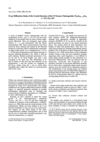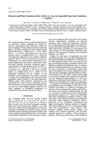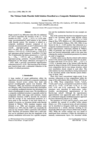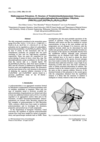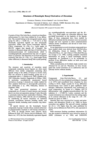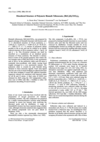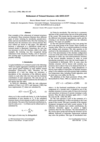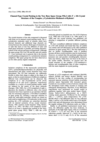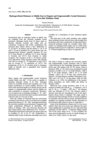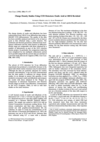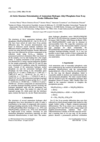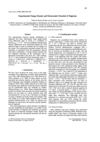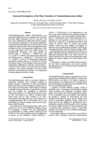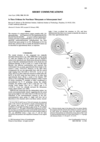issue contents
August 1998 issue

Cover illustration: Space filling representation of the hydrated anionic framework formed by trimesic acid around piles of cobalticinium cations in crystalline [(C5H5)2Co][(H3TMA)(H2TMA)].2H2O. Graphics (picture or drawing) obtained using SCHAKAL by E. Keller, University of Freiburg, Germany. Courtesy of D. Braga and F. Grepioni
research papers
Download citation


Download citation


A previous single-crystal X-ray and electron diffraction structure study of the heavily faulted monoclinic alloy phase β-Al4.5FeSi has been further refined by synchrotron powder data. Based on high-resolution electron microscopy and electron diffraction the basic structure and superstructures are described in terms of faulted stackings of a tetragonal sub-unit.
Download citation


Download citation


Single crystal and powder methods have been used to study a series of thallium ternary chalcogenides which are isostructural with the binary semiconductor TlSe. The unit-cell parameters, cell volume, and In-Se and Tl-Se bond lengths vary with x in the series according to Kurnakov's law.
Download citation


Download citation


P4W24O80, the m = 12 member of the monophosphate tungsten bronze family of the general formula (PO2)4(WO3)2m, has been synthesized. Resolution of its crystal structure from X-ray diffraction data shows that it crystallizes in the orthorhombic system with unit-cell dimensions a = 5.312(1), b = 6.5557(8), c = 42.196(8)Å and space group P212121 (final reliability factor R = 0.0284; wR = 0.0272).
Download citation


Download citation


The crystal structures of β-Ag7PSe6 and γ-Ag7PSe6, two polymorphic forms of the argyrodite Ag7PSe6 compound, are determined from single-crystal X-ray diffraction data. The silver ionic diffusion paths in the high-temperature form are studied by means of a Gram–Charlier non-harmonic development of the atomic displacement factor. The analysis reveals for silver a preference for various low coordination selenium environments, a key feature for ionic conductivity.
A systematic variation in morphology is observed between early- and late-growth crystals of six water-soluble ionic compounds. These morphologies have been successfully modeled using Coulomb-only potentials.
The refinement results for one composition within the solid solution demonstrate that reducing the number of refinable parameters leads to lower R values.
Download citation


Download citation


Fifteen tests based upon X-ray diffraction data and seven tests based on physical measurement are presented for resolving centrosymmetric/noncentrosymmetric space-group ambiguities. The importance of including all reflections in association with their combined standard uncertainties is demonstrated in the elimination of systematic bias before the tests are applied.
Download citation


Download citation


The preparation of anhydrous ferroelectric aminoguani- dinium(2+) hexafluorozirconate is often accompanied by several related materials including the nonpolar monohydrate. The structure of CN4H8ZrF6.H2O has been redetermined to improve the understanding of the preparation pathway, locate all H atoms and compare the remaining structure with that reported previously.
CCDC reference: 131986
Download citation


Download citation


A crystal structure is described in which phosphorus coordinates to a six-membered ring arrangement of MoO6 octahedra, forming a new type of heteropolymolybdate. The monomeric unit was used to deduce the structures of the (C6H5P)Mo62− and (C6H5P)Mo74− species found in aqueous solution.
CCDC reference: 131985
Download citation


Download citation


Distortions of homoleptic benzyl derivatives of zirconium from tetrahedral geometry have been noticed and discussed along with crystal packing.
Download citation


Download citation


The 1:1 disordered structure of P21/m symmetry consists of polymeric chains parallel to the a axis and can be related to an ideally ordered structure of B21/a symmetry, with a' = 2 a, b' = b and c' = 2 c. This B-centred structure can itself be described as a modulation of an idealized parent structure of Pnma symmetry. The disorder is rationalized in terms of the pseudo-symmetry that relates the two formula units of Bi(C6H5COO)3 in the asymmetric unit of B21/a. Each Bi is nominally nine-coordinate.
CCDC reference: 131991
Download citation


Download citation


Four examples of the refinement of twinned structures are discussed. These structures illustrate three different types of twins: twinning by merohedry, pseudo-merohedry and non-merohedral twins.
CCDC reference: 131989
Download citation


Download citation


Inclusion complexes of the macrocyclic host molecule γ-cyclo- dextrin crystallize preferably in the extremely rare space group P4212. The packing characteristics of these compelxes are described.
CCDC reference: 131990
Geometrical data on hydrogen bonds to halide ions are compiled for 25 donor types. Information on hydrogen-bond directionality is also given.
For water molecules donating two Ow-H⋯O hydrogen bonds, the correlation of the covalent H-O-H angle with the O⋯Ow⋯O angle is inspected from 49 neutron crystal structures. Compared to the sample average, the water angle is opened for large and narrowed for small O⋯Ow⋯O angles.
Download citation


Download citation


The suitability of CCD data for charge density studies has been established by comparison of the results of a new study of oxalic acid dihydrate with those of previous studies.
CCDC reference: 1022023
Download citation


Download citation


The structures of the ammonium hydrogen alkyl phosphates NH4PO2(OH)(OR) [R = Me (1), Et (2), Pri (3)] are characterized by an extended hydrogen-bonding network involving the hydrogen phosphate units and the ammonium ions, forming double layers. These layers are separated from each other by van der Waals contacts between the hydrophobic alkyl groups.
Download citation


Download citation


Low-temperature experimental electron density and electrostatic potential of triglycine are described. Charge transfer between the two molecules of the asymmetric unit is discussed in relation to the multipolar refinement strategy.
Download citation


Download citation


Two reversible first-order phase transitions of [N(CH3)4]2SO4 at 263 and 462 K have been established by differential thermal analysis and temperature-dependent X-ray powder diffraction. The crystal structures of the three phases show increasing disorder of the sulfate sublattice with increasing temperature. An examination of group–subgroup relations is made.
short communications
An earlier description, in space group Cc, of the structure of a mixed CuI–CuII salt led to non-linear conformations for the mixed anions (Se,S)CN. Re-refinement in space group C2/c shows that these anions can be described as linear, as expected.


 journal menu
journal menu












